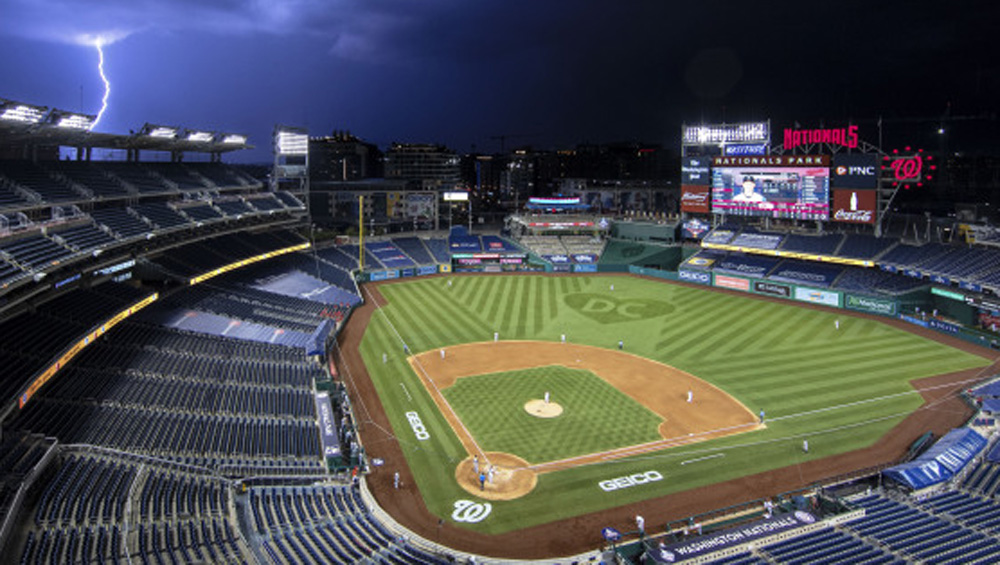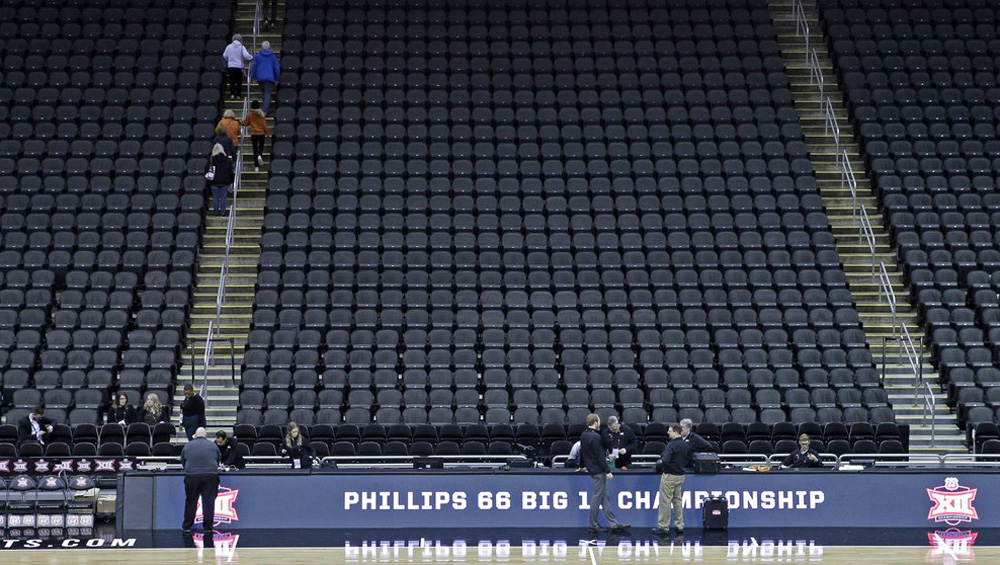
TVN Tech | Pandemic Means New Playbook For Sports Production

Probably no segment of the broadcast industry suffered a bigger blow from the COVID-19 pandemic than sports production. All big league sports in the U.S. shuttered in early March for several months, and major international events like The Masters and Summer Olympics were postponed while others like Wimbledon and the British Open were canceled altogether. That meant no work for mobile trucks and the mostly freelance production crews who run them, and a big ratings and advertising hit for the networks.
Fortunately, mainstream sports production resumed with NASCAR races in May followed by MLB, NBA and NHL games this summer, albeit with a myriad of new social distancing rules and restrictions, including empty stadiums and arenas. Network field operations executives and mobile vendors have responded by employing new remote production techniques and on-site safety protocols, and have been successful in bringing live coverage to fans at home.
But challenges definitely remain. Several MLB games were postponed this summer due to positive COVID-19 tests among players, and some big college football games were canceled early this fall. And just this week the NFL’s Tennessee Titans had several players test positive, forcing the league to postpone Sunday’s game versus the Pittsburgh Steelers until Monday or Tuesday, if not later.

Don Roberts
“We’re doing the best we can to control the things that we can control,” said Don Roberts, VP of sports engineering and operations for Sinclair Broadcast Group, who was among several sports production experts who gathered last week for the TVNewsCheck Webinar “Producing Events in a Pivotal Year,” moderated by this reporter. “A bunch of it you just can’t; you have to flexible enough to roll with the punches.”
The near-term changes to TV sports production have been significant. And some, like an increased use of remote and distributed workflows and a reduction in overall travel for production staff, are expected to last beyond the pandemic. Fox was already working on a “production anywhere” model where teams of the same core personnel consistently work together to produce games remotely, allowing them to spend less time in airplanes and more time bringing content to air. NEP is using this sort of distributed production model to produce sports all over Australia from two hubs in Sydney and Melbourne.
“One of the big things we’ve all learned in the last six months has been the plan that was 12, 18 or 24 months out, in what we were going to do operationally and capital-wise, has been modified and accelerated in some cases,” said Brad Cheney, VP of field operations and engineering for Fox Sports.
Fewer People On Site
The biggest near-term effect of COVID-19 has been fewer people on the ground helping to produce events. Where possible, Fox has been using fiber connections to do “home-run productions” with most personnel at its network centers in Los Angeles or Charlotte, N.C. It is also using IP links to provide access to resources like editing systems for employees working from home, using remote desktop software from vendors like Teradici.

Brad Cheney
Fox currently has 20% less personnel when covering an NFL game, Cheney said, and probably had over 50% less onsite personnel for baseball and NASCAR coverage where most of the production was done remotely. It varies by sport and venue. Out of three college football games last weekend, two were produced onsite with probably 20% less staffers than usual, while a third was done as a home-run production with less than half the number of personnel who would normally be onsite.
“The leagues and our partners have asked us to find a way to do this with less people on site because less people onsite means less people interacting, which mean less possibility of any kind of spread of any illness that’s out there,” he said. “And all of the leagues have done a great job with their safety protocols, to say where our staff can be and where they can’t be.”
In the past, Fox personnel used to be able to enter the left field gate of a baseball stadium and walk through the warning track and down the side of the field to access a low camera position. That is no longer allowed. Now Fox crews have to enter through the stadium and go through health checks beforehand, and it takes longer to get to a camera or place a microphone. But Cheney says there is still enough access to get the job done.
Robotic Cameras, Better Views
For its MLB coverage, Sinclair’s regional sports networks (RSNs) are employing robotic cameras instead of traditional units in some places due to the new rules.
“The credentials for crews are different now,” Roberts said. “Not everyone can be in the dugout, for example, not everyone can be right on top of players. You augment that with robo-cameras instead of manned cameras.”
Both he and Cheney said the lack of fans in the stands has made it easier to place equipment in low camera positions, like behind home plate, as well as experiment with new locations for microphones. That can actually result in better coverage for home viewers, such as foul-line cameras that shoot right down the line instead of being offset slightly.
Sinclair’s RSNs are still bringing most of the normal crew complement onsite, but are splitting them among two trucks now to facilitate social distancing, Roberts said. In most cases the RSN is producing a single “world feed” that both it and network partners are using, though sometimes networks augment it with their own additional cameras.
Tennis Channel Gets Lean
Things are very different for Sinclair’s Tennis Channel, which is currently in the midst of covering the Roland Garros major tennis tournament (aka the French Open) in Paris. That event was postponed four months from its usual late May-early June timeframe.
“That crew, and the people we traveled, is at least 50% to 60% less than we have in the past,” Roberts said. “First of all, you’ve got to get people out of the country. And secondly, the way we’re going to cover that and handle that is more of a world-feed type thing than a very specific Tennis Channel production. So it’s dramatically different than it’s been in the past.”
Sinclair was responsible for some of the first mainstream live professional sports to be broadcast this spring after the COVID-19 lockdowns, with Tennis Channel covering two small ad-hoc tennis tournaments in May. The men’s and women’s UTR Pro Match Series events were held on a private court in the backyard of a residential home in West Palm Beach, Fla., with no spectators or public access, and were covered by a small crew of six to eight people using a single mobile truck and four to five cameras.
For its subsequent tournaments, Tennis Channel has kept its on-site presence lean, with a much smaller group than usual traveling to each venue.
“It’s changed the face of how we produce tennis, for sure,” Roberts said. “We’re going to see what next year brings, but we still have a full schedule of events we’re planning to cover. The same thing with the RSNs, with MLB, the NHL and NBA, we’re keeping our fingers crossed that we can produce all of that content. Probably some way different than we have in the past, but maybe a little better than what we’re doing today.”
Trucks Staying Put

Phil Garvin
Phil Garvin, CEO of mobile vendor Mobile TV Group, says one big change due to COVID-19 is that once a production truck travels to a venue, it’s probably going to be there for a while. One of his company’s trucks set up at an MLB stadium in late July and didn’t move until early this week after the regular season wrapped up.
“Anybody who wants a feed out of that venue for an MLB game is using us, so there’s not a lot of moving in and out,” Garvin said. “That’s very helpful in controlling personnel and controlling the flow of the disease.”
There are severe limits on which personnel can go into a venue to deal with a technical problem, which Garvin said has been a challenge at times. But social distancing has been made relatively easy with the new reliance on a single generic “world feed” for many events instead of the typical “home” and “away” feeds, each tailored to different audiences and supported by its own truck. Mobile TV Group still rolls two trucks to a venue, but now they both work together to support the world feed. That allows personnel to spread out.
“You can put half of your replay operators in the first unit, and the other half in the other unit, and so on,” Garvin said. He notes that producers would still prefer to have a differentiated feed versus a generic world feed, a problem he and other mobile vendors are working to solve.
His company has installed plexiglass dividers in its mobile units to help enforce social distancing. They include a special movable divider installed in the video shading area which allows several staffers to work together safely while sharing the same reference monitor.
LiveU’s Sports Usage Grows

Janel Fleming
IP contribution vendor LiveU was used widely by broadcasters for news production before COVID-19 hit, but its foothold in sports was in niche events targeted for OTT distribution such as rugby and lacrosse. COVID-19 caused a change in mindset, said LiveU Director Of Sports Sales Janel Fleming, as linear broadcasters started relying on LiveU to support different hybrid REMI [remote integration] production workflows for sports.
That could mean using a LiveU portable encoder to support network talent doing live shots from their home, or handling backhaul for unique sports like cornhole that made their way to broadcast air amid the vacuum of big-time sports.
“We’ve seen a huge increase in usage,” said Fleming, who adds that LiveU has added to its cloud infrastructure with Amazon Web Services to help handle the load.
Across both news and sports applications, usage of LiveU’s mobile app went up 400% in April. Average session times also increased from the normal 15 minutes for news applications to over an hour of streaming.
“Sports has been in this transition to start looking at IP technologies and unmanaged network solutions,” Fleming said. “To see some of these broadcasters start taking us up on what we’ve been telling them to do was exciting to see, even in this uncertain time.”
Cheney says some high-profile Fox shows and talent are now relying on home broadband connections for key applications.
“We’re up hundreds of percent in using high-speed internet to do things that in the past we used private, dedicated internet for,” he said.
Solving For Missing Crowds
Networks have taken a different approach to dealing with the lack of fans in the stands. For baseball and football, Fox has used preproduced crowd audio, as well as virtual fan graphics, to try to replicate the feel of pre-COVID sports as much as possible. That wasn’t necessary for NASCAR, which is loud enough on its own.
 “The sounds of the crowd, and having a crowd, we thought helped people escape reality a little more, and get back into the nostalgia of watching baseball,” Cheney said.
“The sounds of the crowd, and having a crowd, we thought helped people escape reality a little more, and get back into the nostalgia of watching baseball,” Cheney said.
Sinclair has used league-provided crowd audio for baseball, hockey and basketball, said Roberts, who noted that the leagues pump the same audio into the stadiums and arenas for the players’ benefit. It hasn’t used any virtual graphics to simulate fans.
“We’re typically just picking up that audio from the stadium,” he said. “We’re not augmenting it with anything else.”
UHD Production Slows
The long hiatus in sports production has slowed the growth of UHD production, whether that means 1080p HDR or 4K. Garvin says that Mobile TV Group used to do 20 to 30 UHD events for the NBA, but that didn’t happen in the bubble the league created in Orlando. It also hasn’t done 1080p HDR productions for Fox since COVID hit.
“You didn’t need another layer of work during this complicated time,” Garvin said. “But I don’t see any reason why it won’t come back.”
Cheney agreed that Fox is “definitely behind” on its initial UHD plans for 2020, which included most regular season baseball. But he noted that Fox is currently producing one college football game in 1080p HDR every Saturday and upconverting it for 4K distribution.
Fox will produce one of the National League Division Series in 1080p HDR and then carry that through the World Series. And when Thursday Night Football launches tonight, it will be produced in 1080p HDR, like last season.
For the first time, Tennis Channel will be producing and distributing Roland Garros coverage in 4K to select pay TV providers. Sinclair is also currently building a new technical operations center for the RSNs that will be 1080p-native and also have some 4K capability.
“We as a company have always been huge proponents of 1080p/60 HDR, and we’re going to go down that path when the time is right,” Roberts said. “But we’re positioning ourselves now to be able to do that pretty quickly. We see that as where we want to end up, that’s the sweet spot.”


































Comments (0)